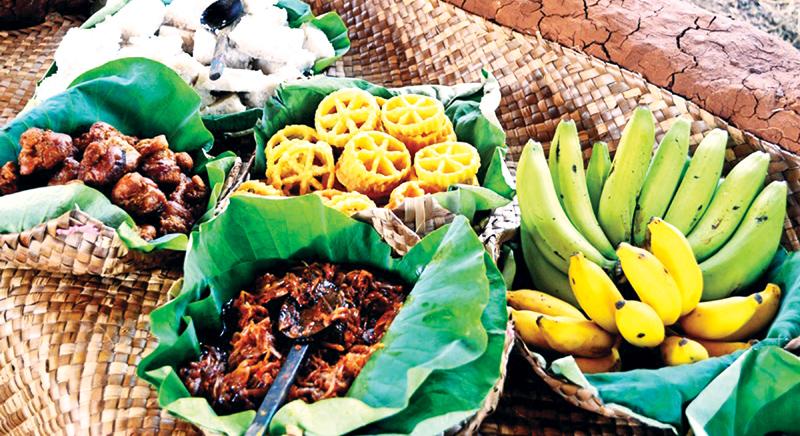
April is the month of many delightful memories. It is the first term of school holidays for children. It is a month of joyful aspirations. To many of us Aluth Avurudu is synonymous with the succulent sweets made by both the Sinhalese and Tamil communities as we celebrate a Sri Lankan festival. Ah! How we cherish every bite of those dainty, yet somewhat oily sweets.
 Chef Publis Silva |
With a focus on organic cuisine and a healthy lifestyle, one is subject to a feeling of temporary guilt when indulging in these tempting goodies. Living in crowded cities supplemented by a busy work oriented lifestyle do our women have the time and mastery of cooking skills to keep this tradition alive? Are the long hours of making these sweets appreciated, or will they be replaced with “fusion sweets” in the future?
The konde kevum is the alluring queen who reigns high above the other sweets on the plate. Her “konde” has a class of its own! She is always soft to the touch, and mother used to warn me not to succumb to her charms! The kalu dodol is the grand duke of Sinhala sweets. The dark brown exterior gives way to a warm consistency. I used to be puzzled about the Aasmi- somewhat similar to a hybrid string hopper with a touch of red syrup.
The halape was a favourite of my late father, we used to eat this at sunset drinking a glass of ginger infused tea. We yielded to the others as well: athiraha and mung kavum- nutritious sweets. The kokkis was a class of its own. Today, it is sold in packets with a chili and salt dusting, giving it a savoury classification. The kiri bath (milk rice) dazzles us in various shapes and types of grain- red rice, samba and the opulent basmati rice.
 Sweets made by Tamil families include laddu, jelibi, paitham paniyaram, sugar coated sippi and murruku. Finding clean banana leaves to place on plates is another challenge for the denizens of the city. I did come across some ceramic plates that were wisely made in green to reflect a banana leaf.
Sweets made by Tamil families include laddu, jelibi, paitham paniyaram, sugar coated sippi and murruku. Finding clean banana leaves to place on plates is another challenge for the denizens of the city. I did come across some ceramic plates that were wisely made in green to reflect a banana leaf.
The New Year is not about eating sweets. It is a continuous reunion and fellowship of all communities. We must change the customary label of Sinhala and Tamil New Year to incorporate all communities and celebrate this time as a Sri Lankan festival. It is a time not to be divided on avenues of religion. It is a time to strengthen our national identity as one people.
The food associated with Aluth Avurudhu, is being subject to change. Of course, change is important as we make progress. Yet, it is sad to see that these timeless traditions, in a culinary sense are being replaced in Colombo and perhaps other major cities. The primary reason given is that working women don’t have time to sit and make sweets- this is true.
The second reason is a practical one, people living in high rise apartment complexes can’t be pounding and deep frying as the neighbours would be disturbed and the prolonged cooking can present a fire hazard. This is reality and there is no option.
While some housewives have got into the practice of buying avurudu sweets from various outlets selling ‘commercially made’ sweets, some are trying to ‘Google’ and find traditional recipes and make them at home, with their children. A few prudent ones have even ventured into altering cooking patterns creating avurudu fusion food. Some ingredients are a bit expensive- a common element in any celebration. One place taking orders for Tamil oriented sweets in Wellawatte is Vasantham Foods on Galle Road. The boys there are optimistic that their orders will increase in the future.
I also spoke to veteran Chef Publis Silva, who has made rasa kevili for many decades. The amiable Chef said, “One of the primary reasons contributing to the decline of traditional sweet making is the cost. Ingredients are costly. The second is rapid urbanization which is now entering the once serene villages. Our food culture is subject to various influences”. Explaining further Chef Publis points out, “We must adapt to change, yet maintain our heritage.
Look at the aasmi made today, it is too large and therefore people hesitate to eat it wondering if they can finish it. So we have to be practical when deciding size. Aasmi must be reduced to a smaller portion”. The prudent chef also says, items like kenda kola to wrap halape will soon be extinct, so he says, we can present the halape in a new form.
Thankfully, most of us adhere to sustain the culinary tradition by at least purchasing ready made avurudu kevili. Many of us at the end of these blissful days will return to office and faithfully drink green tea and enlist in a weekend aerobics class! The real essence of the avurudu sweets is not in the eating, it is the joyous fellowship where the sweets are brought to life by hand.
This is an extension of family time, with cousins and relatives. We build bridges of love by sharing the plates of sweets with the neighbours.
We must uphold the heritage filled recipes of our nation; some things in life cannot be compromised.
